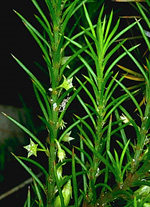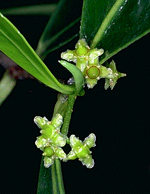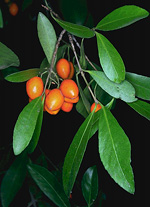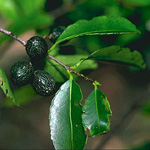 |
This is a moderate-sized cosmopolitan family, most diverse in the tropics. Most species in Australia are found in wet or dry rain forests or savannah woodlands of the north and east. One genus (Psammamoya, a leafless shrub) is found in south-west Western Australia.
Characteristic features of the family Celastraceae in Australia include: - trees, shrubs or climbers with alternate or opposite, simple leaves (reduced to scales in Psammamoya)
- flowers small, open, with 3-5 free sepals, petals and stamens, and a conspicuous, glandular disc
- ovary superior or half-inferior and partially immersed in disc, with 3-5 carpels and a short style
- fruit either a drupe or capsule, the seeds often enveloped by a pulpy, brightly-coloured aril
Description
Evergreen trees, shrubs or woody vines climbing by twining or scrambling stems. Leaves occasionally ±absent. Vegetative reproduction ?absent. Stem internodes terete or distinctly angular. Internal secretions not obvious. Plants glabrous or with simple or stellate, non-glandular, uniseriate hairs. Leaves well developed or much reduced (i.e. to scales, etc.), alternate and spiral, or distichous, or opposite, petiolate or subsessile. Stipules absent or present, distinct and free from the petiole; scale-like or membranous, bristle-like, lacerate or fimbriate, falling off early or persistent. Lamina simple, symmetric, filiform, acicular, subulate, linear, lanceolate, ovate, elliptic, oblanceolate, obovate or oblong; base cuneate, attenuate, rounded, or rarely cordate; margins entire, crenate, dentate or serrate, ±flat, revolute or recurved; venation pinnate, midrib conspicuous, the tertiary venation reticulate; surfaces not punctate; herbaceous. Domatia absent or consisting of pits or pockets in the vein angles. Male and female flowers occurring on the same plant or on different plants, or usually with all the flowers bisexual. Inflorescences terminal or axillary, consisting of panicles, cymes or solitary flowers. Bracts present. Bracteoles present or absent. Flowers odourless; stalked. Floral disc present or absent; nectaries present on the disc. Perianth regular, of 2 dissimilar whorls, imbricate or valvate in bud. Calyptra present or absent. Calyx segments free or fused, with 3–5 sepals or lobes; calyx bell-shaped, herbaceous or papery. Corolla segments free, with 3–5 petals, alternating with the sepals or calyx lobes, white, cream, red or green, without contrasting markings, membranous or papery; claws absent; lobes ±entire or ciliate or fimbriate. Fertile stamens 2–5, opposite to the sepals or calyx lobes, free of the corolla, free of the ovary and style, distinct from each other, all ±equal. Anthers dorsifixed or basifixed, versatile or not versatile, opening outwards, sideways or inwards by short slits or by longitudinal slits; 2-celled. Ovary superior and sessile. Carpels 2–5, fused; ovary with 1–10 locules. Style terminal, single and unbranched or branched above, or absent and the stigma ±sessile on the ovary. Ovules 1–10 per locule, stalked; placentation axile. Fruit dry or fleshy, dehiscent or indehiscent, a dry or somewhat fleshy loculicidal capsule, or drupe; the perianth on the maturing fruit deciduous or dry and persistent. Disseminule micro-surface ?granulate, yellow, orange, brown, grey or black, glossy or dull. Seeds 1–10 per fruit. Aril present or absent. Cotyledons 2. Embryo straight.
(Note: this description has been generated from the coded data compiled for the key. Any errors in the key data will be reflected in the descriptions.)
A treatment of the family Celastraceae has been published in:
Flora of Australia 22: 150-180.
Australian genera of Celastraceae (as recognised for the Flora of Australia)
Apatophyllum
Cassine
Celastrus
Denhamia
Elaeodendron
Euonymus
Hedraianthera
Hexaspora
Hypsophila
Lophopetalum
Maytenus
Perrottetia
Pleurostylia
Psammomoya
Siphonodon

|
  |

Apatophyllum constablei (flowers)
Photo: A.Lyne © ANBG

Cassine australis (flowers)
Photo: M.Fagg © ANBG

Cassine australis (fruits)
Photo: M.Fagg © ANBG

Cassine curtipendula (fruits)
Photo: D.Jones © D.Jones

|
 |
|